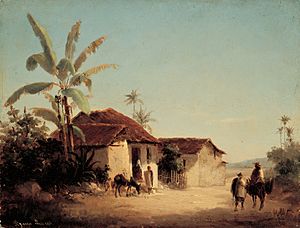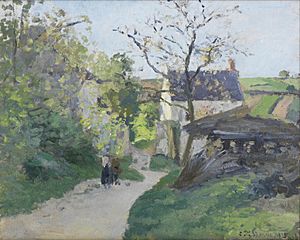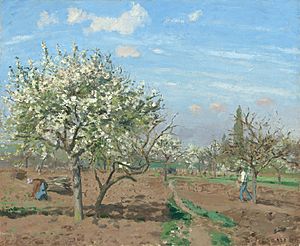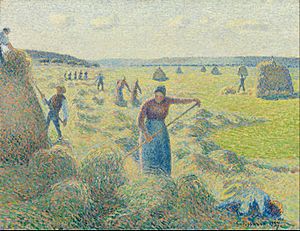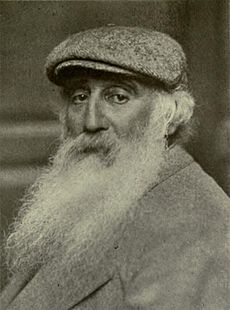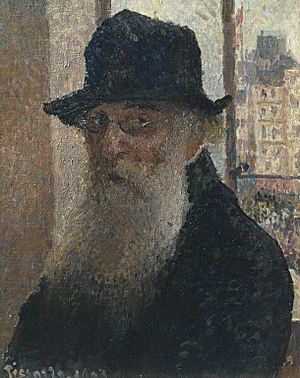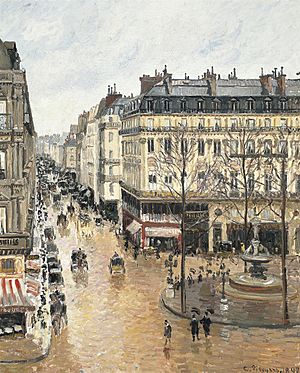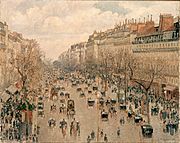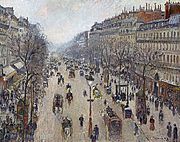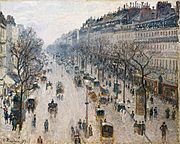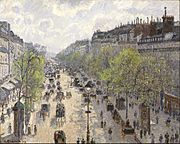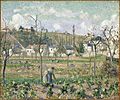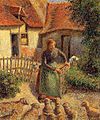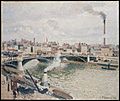Camille Pissarro facts for kids
Quick facts for kids
Camille Pissarro
|
|
|---|---|
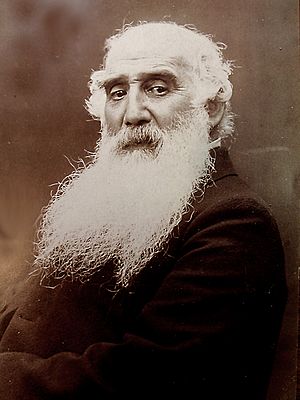
Camille Pissarro, c. 1900
|
|
| Born |
Jacob Abraham Camille Pissarro
10 July 1830 Charlotte Amalie, Saint Thomas, Danish West Indies
|
| Died | 13 November 1903 (aged 73) Paris, France
|
| Nationality | Danish, French |
| Known for | Painting |
| Movement | Impressionism Post-Impressionism |
Camille Pissarro (born July 10, 1830 – died November 13, 1903) was a famous Danish-French painter. He was born on the island of St. Thomas, which was then part of the Danish West Indies.
Pissarro is very important in art history because he helped create both Impressionism and Post-Impressionism. He learned from great artists like Gustave Courbet and Jean-Baptiste-Camille Corot. Later, he worked with Georges Seurat and Paul Signac and tried out a new style called Neo-Impressionism.
In 1873, Pissarro helped start a group of fifteen artists. He was like a "father figure" to them, keeping the group together and encouraging everyone. Art historian John Rewald called him the "dean of the Impressionist painters." This was because he was the oldest and had a wise, kind, and warm personality.
Paul Cézanne said Pissarro was "a father for me." He was also a teacher to Paul Gauguin. Pierre-Auguste Renoir called Pissarro's art "revolutionary." Pissarro liked to paint everyday people in natural settings, without making them look too grand.
Pissarro was the only artist to show his work at all eight Impressionist exhibitions in Paris, from 1874 to 1886. He was a mentor not only to the Impressionists but also to four major Post-Impressionists: Cézanne, Seurat, Gauguin, and van Gogh.
Contents
Early life and art beginnings
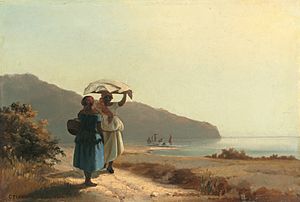
Jacob Abraham Camille Pissarro was born on July 10, 1830, on the island of St. Thomas. His father was of Portuguese Jewish background and had French nationality. His mother was from a French-Jewish family on St. Thomas. His father was a merchant.
When Pissarro was twelve, his father sent him to boarding school in France. He studied at the Savary Academy near Paris. There, he learned to love the works of French art masters. His teacher, Monsieur Savary, taught him a lot about drawing and painting. He told Pissarro to draw from nature when he went back to St. Thomas.
After school, Pissarro returned to St. Thomas when he was sixteen or seventeen. His father wanted him to work in the family business as a port clerk. But Pissarro used every chance he got during those five years to draw during breaks and after work.
A writer named Nicholas Mirzoeff believes that Pissarro was inspired by the art of James Gay Sawkins. Sawkins was a British painter who lived in Charlotte Amalie, St. Thomas, around 1847. Pissarro might have taken art classes from Sawkins. He also saw Sawkins's paintings of Mexico. Mirzoeff says that Sawkins's work influenced the young Pissarro. Pissarro soon began drawing local people, similar to Sawkins's style.
When Pissarro was twenty-one, a Danish artist named Fritz Melbye inspired him to become a full-time painter. Melbye became his teacher and friend. Pissarro then decided to leave his family and job. He moved to Venezuela with Melbye. They spent two years working as artists in Caracas and La Guaira. He drew everything he saw, including landscapes, village scenes, and many sketches.
Life in France
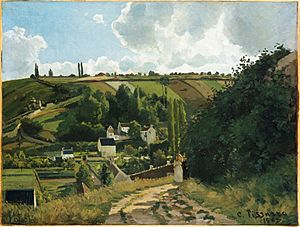
In 1855, Pissarro moved back to Paris. He worked as an assistant to Anton Melbye, Fritz Melbye's brother. He also studied paintings by artists he admired, such as Courbet, Charles-François Daubigny, Jean-François Millet, and Corot. He took classes at schools like École des Beaux-Arts and Académie Suisse. But Pissarro found these teaching methods "stifling," or too strict. So, he asked Corot for different lessons, and Corot agreed.
Early Paris art and Corot's influence
Pissarro's first paintings followed the rules of the Paris Salon. The Salon was the official art group that decided which art was good enough to show. Its yearly exhibition was the main way for young artists to become known. So, Pissarro painted in a traditional way to please the Salon's committee.
In 1859, his first painting was accepted and shown. His other paintings from that time were influenced by Camille Corot, who taught him. Pissarro and Corot both loved painting country scenes from nature. Corot inspired Pissarro to paint outdoors, a style called "plein air" painting. Pissarro thought Corot's and Courbet's work showed "pictorial truth." He often talked about their art. He also admired Jean-François Millet's paintings of country life.
Painting outdoors
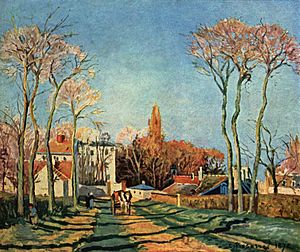
During this time, Pissarro began to understand how important it was to show the beauty of nature exactly as it was. After a year in Paris, he started leaving the city to paint scenes in the countryside. He wanted to capture the daily life of villages. He found the French countryside "picturesque," meaning it was beautiful and worth painting. It was mostly farmland then, sometimes called the "golden age of the peasantry." Pissarro later explained how to paint outdoors to a student:
"Work on the sky, water, branches, and ground all at the same time. Keep everything going equally and keep working until you get it right. Paint freely and without hesitation, because it's best not to lose your first feeling."
Corot would finish his paintings in his studio, often changing them. But Pissarro liked to finish his paintings outdoors, often in one sitting. This made his work feel more real. Because of this, his art was sometimes criticized as being "vulgar." This was because he painted exactly what he saw, like "mounds of earth, and trees in different stages of growth." This different style caused some disagreements between Pissarro and Corot.
Working with Monet, Cézanne, and Guillaumin
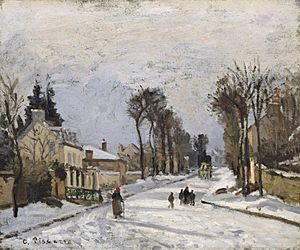
In 1859, Pissarro became friends with younger artists at the free school, the Académie Suisse. They also liked to paint in a more realistic style. Among them were Claude Monet, Armand Guillaumin, and Paul Cézanne. They all shared a dislike for the strict rules of the Salon. Cézanne's work was often made fun of by others at the school. But, as Rewald writes, Cézanne "never forgot the kindness and understanding with which Pissarro encouraged him." Being part of this group made Pissarro feel better, knowing he wasn't alone in his art struggles.
Pissarro agreed with the group that it was important to show people in natural settings. He disliked any fake or grand feeling in his art, even though the Salon wanted it. In 1863, almost all of the group's paintings were rejected by the Salon. So, French Emperor Napoleon III decided to show their paintings in a separate hall, called the Salon des Refusés. Only Pissarro's and Cézanne's works were included. This separate show caused a lot of anger from both the Salon officials and the public.
In later Salon shows in 1865 and 1866, Pissarro gave credit to Melbye and Corot as his teachers. But in 1868, he no longer listed other artists as influences. This showed he was becoming independent as a painter. Art critic Émile Zola noticed this and said:
"Camille Pissarro is one of the three or four true painters of this day... I have rarely seen such a sure technique."
Another writer described Pissarro's style: "The brightness of his colors makes objects feel like they are surrounded by air... He paints the smell of the earth." Even though Pissarro's paintings were hung high up near the ceiling at the Salon, art lovers still noticed their quality. By age thirty-eight, Pissarro was becoming known as a landscape painter who could rival Corot and Daubigny.
In the late 1860s or early 1870s, Pissarro became very interested in Japanese prints. This made him want to try new ways of composing his art. He described this art to his son Lucien:
"It is wonderful. This is what I see in the art of this amazing people... nothing that jumps out, a calm, a greatness, an amazing unity, a rather soft brightness..."
Family life
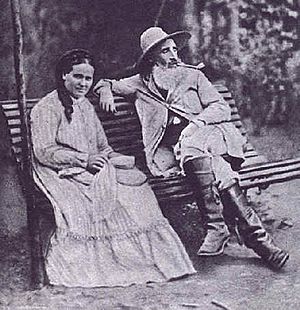
In 1871, in Croydon, England, Pissarro married Julie Vellay, his mother's maid. She was a vineyard grower's daughter. They had seven children together. Six of them would become painters: Lucien Pissarro (1863–1944), Georges Henri Manzana Pissarro (1871–1961), Félix Pissarro (1874–1897), Ludovic-Rodo Pissarro (1878–1952), Jeanne Bonin-Pissarro (1881–1948), and Paul-Émile Pissarro (1884–1972). They lived outside Paris in Pontoise and later in Louveciennes. These places inspired many of his paintings, including scenes of village life, rivers, woods, and people working. He also stayed in touch with his artist friends, especially Monet, Renoir, Cézanne, and Frédéric Bazille.
Time in London
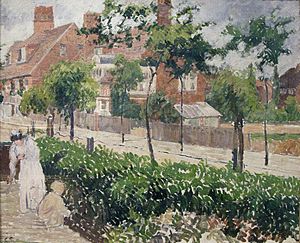
When the Franco-Prussian War started in 1870–71, Pissarro only had Danish nationality. He could not join the army. So, he moved his family to Norwood, a village near London. However, his painting style, which was new and later called "Impressionism," did not sell well there. He wrote to his friend, Théodore Duret, that "my painting doesn't catch on, not at all..."
In London, Pissarro met the art dealer Paul Durand-Ruel. Durand-Ruel became the dealer who helped sell his art for most of his life. Durand-Ruel also introduced him to Monet, who was also in London at that time. They both saw the work of British landscape artists John Constable and J. M. W. Turner. This made them believe even more that painting outdoors showed light and atmosphere best. They felt this could not be done in a studio. Pissarro's paintings also started to look more spontaneous, with loose brushstrokes and thick paint, giving them more depth.
Paintings from London
Pissarro's paintings from this time show Sydenham and the Norwoods. These areas had just gotten railways but were not yet full of suburbs. One of his largest paintings from this time is The Avenue, Sydenham, which shows St. Bartholomew's Church. It is now in the National Gallery in London. Twelve oil paintings from his time in Upper Norwood are known. These include Norwood Under the Snow and Lordship Lane Station. He also painted views of The Crystal Palace, Dulwich College, and Sydenham Hill.
Pissarro returned to France and lived in Pontoise from 1872 to 1884. In 1890, he visited England again and painted about ten scenes of central London. He came back in 1892, painting in Kew Gardens and Kew Green. In 1897, he painted several scenes of Bedford Park and Chiswick.
French Impressionism
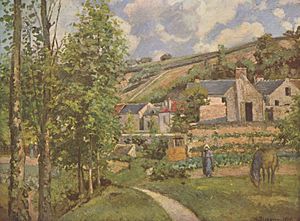
When Pissarro returned to France after the war, he found that only 40 of his 1,500 paintings from 20 years were left. He had to leave them behind when he moved to London. The rest were damaged or destroyed by soldiers. Many of the lost paintings were in the Impressionist style he was developing. This means they would have shown the "birth of Impressionism." Art critic Armand Silvestre even called Pissarro "basically the inventor of this [Impressionist] painting." However, Pissarro's role was more like a "good counselor and peacemaker." Monet was seen as the main leader.
Pissarro quickly became friends again with the other Impressionist artists. This group included Cézanne, Monet, Manet, Renoir, and Degas. Pissarro told the group that he wanted an alternative to the Salon. He wanted their group to show their own unique styles.
To help with this, in 1873, he helped create a separate group called the "Société Anonyme des Artistes, Peintres, Sculpteurs et Graveurs." It had fifteen artists. Pissarro wrote the group's first rules and was key to starting and keeping the group together. One writer noted that with his early grey beard, the forty-three-year-old Pissarro was seen as a "wise elder and father figure" by the group. Yet, he could work with the other artists as equals because he was still youthful and creative.
Impressionist exhibitions
The next year, in 1874, the group held their first 'Impressionist' Exhibition. It shocked and "horrified" the critics. Critics usually only liked paintings of religious, historical, or mythological scenes. They found many faults with the Impressionist paintings:
- The subjects were seen as "vulgar" and "common." They showed everyday people doing everyday things. Pissarro's paintings, for example, showed muddy and messy scenes.
- The way they painted was too quick and looked unfinished. This was especially true compared to traditional styles. The artists used visible brushstrokes, which was seen as an insult to traditional artists. Traditional artists often spent weeks on their work. But Impressionist paintings were often done in one sitting, with wet paint applied over wet paint.
- The Impressionists used color in new ways. For example, they painted shadows with the reflected light from surrounding objects.
A "revolutionary" style
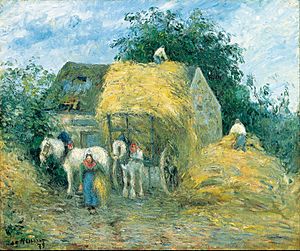
Pissarro showed five of his paintings, all landscapes, at the exhibition. Again, Émile Zola praised his art and that of the others. But in the 1876 Impressionist exhibition, art critic Albert Wolff complained. He wrote, "Try to make M. Pissarro understand that trees are not violet, that sky is not the color of fresh butter..." On the other hand, journalist Octave Mirbeau wrote, "Camille Pissarro has been a revolutionary through the new working methods he has given to painting."
According to Rewald, Pissarro had a simpler and more natural approach than the other artists. He writes:
"Instead of making the peasants' tough lives seem grand, he placed them naturally in their usual surroundings. He became an objective recorder of one part of modern life."
In later years, Cézanne remembered this time and called Pissarro "the first Impressionist." In 1906, a few years after Pissarro died, Cézanne was 67 and a role model for new artists. He showed his respect for Pissarro by listing himself in an exhibition catalog as "Paul Cézanne, pupil of Pissarro."
Pissarro, Degas, and American Impressionist Mary Cassatt planned a journal of their original prints in the late 1870s. But this project never happened because Degas pulled out. Art historian Joachim Pissarro, who is the artist's great-grandson, notes that they "strongly disliked the Salons and refused to exhibit there." They shared a strong determination against the Salon. Their letters show that they admired each other for both their art and their beliefs.
Cassatt had become friends with Degas and Pissarro years earlier. She joined Pissarro's new French Impressionist group. She gave up chances to show her art in the United States. She and Pissarro were often treated as "two outsiders" by the Salon. This was because neither of them were French citizens. However, she was "fired up" to promote Impressionism. She looked forward to exhibiting "out of loyalty to her new friends." Towards the end of the 1890s, she started to distance herself from the Impressionists. She sometimes avoided Degas because she couldn't handle his "wicked tongue." Instead, she preferred the company of "the gentle Camille Pissarro." With him, she could talk openly about how art was changing. She once said he was a teacher "that could have taught the stones to draw correctly."
Neo-Impressionist period
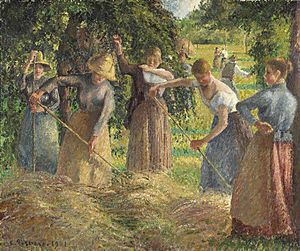
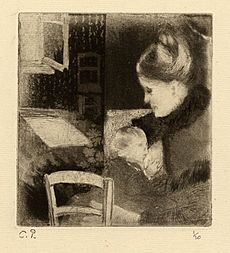
By the 1880s, Pissarro started to try new ideas and painting methods. He felt he was stuck in an artistic "mire." So, Pissarro went back to his earlier themes. He painted the lives of country people, just as he had done in Venezuela when he was young. Degas described Pissarro's subjects as "peasants working to make a living."
However, this time also marked the end of the Impressionist period for Pissarro. As Joachim Pissarro explains:
"Once such a strong Impressionist as Pissarro had turned away from Impressionism, it was clear that Impressionism had no chance of surviving..."
During this time, Pissarro wanted to "educate the public." He did this by painting people at work or at home in realistic ways. He did not make their lives seem perfect. Pierre-Auguste Renoir, in 1882, called Pissarro's work from this period "revolutionary." This was because he tried to show the "common man." Pissarro himself did not use his art to preach political messages. But he preferred painting humble subjects for his upper-class clients to see and buy. He also began painting with more connected brushstrokes and pure colors.
Learning from Seurat and Signac
In 1885, he met Georges Seurat and Paul Signac. They used a more "scientific" way of painting. They used very small dots of pure colors to create the illusion of blended colors and shading when seen from a distance. This technique is called pointillism. Pissarro spent the years from 1885 to 1888 practicing this method. It took a lot of time and effort. The paintings he made were very different from his Impressionist works. They were shown in the 1886 Impressionist Exhibition, but in a separate section. Works by Seurat, Signac, and his son Lucien were also there.
These four works were seen as an "exception" at the eighth exhibition. Joachim Pissarro notes that almost every reviewer who talked about Pissarro's work mentioned "his amazing ability to change his art, rethink his ideas, and take on new challenges." One critic wrote:
"It is hard to talk about Camille Pissarro... Here we have a fighter from way back, a master who keeps growing and bravely tries new theories."
Pissarro explained the new art form as "a step in the logical progress of Impressionism." But he was the only Impressionist with this view. Joachim Pissarro says that Pissarro became the "only artist who went from Impressionism to Neo-Impressionism."
In 1884, art dealer Theo van Gogh asked Pissarro if his older brother, Vincent, could stay at his home. Lucien Pissarro wrote that his father was impressed by Van Gogh's work. He had "seen the power of this artist," who was 23 years younger. Van Gogh never stayed with him. But Pissarro did explain to him different ways to find and express light and color. Lucien notes that Van Gogh later used these ideas in his paintings.
Leaving Neo-Impressionism
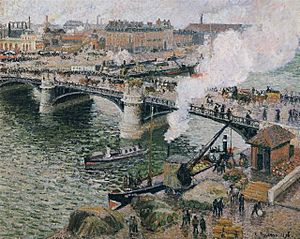
Pissarro eventually stopped using Neo-Impressionism. He felt its system was too artificial. He explained in a letter to a friend:
"After trying this theory for four years and then giving it up... I can no longer call myself one of the neo-impressionists... It was impossible to be true to my feelings and therefore to show life and movement. It was impossible to be faithful to the random and wonderful effects of nature. It was impossible to give my drawing an individual character, so I had to give up."
However, after he returned to his earlier style, his work became "more subtle, his colors more refined, his drawing firmer," according to Rewald. "So Pissarro approached old age with greater skill."
But this change also added to Pissarro's constant money problems. He felt them until he was in his 60s. Joachim Pissarro writes that his "strong courage and determination to be an artist" came from his "lack of fear of what would happen right away" because of his style choices. Also, his work was strong enough to "boost his spirits and keep him going." His Impressionist friends saw his independence as a "sign of honesty." They often asked him for advice, calling him "Père Pissarro" (father Pissarro).
Later years
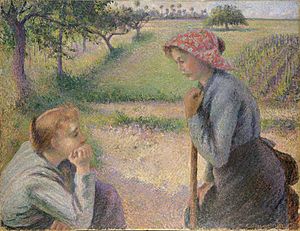
When he was older, Pissarro had a recurring eye infection. This kept him from working outdoors except in warm weather. Because of this, he started painting outdoor scenes from hotel room windows. He often chose hotel rooms on higher floors to get a wider view. He moved around northern France and painted from hotels in Rouen, Paris, Le Havre, and Dieppe. He did the same on his visits to London.
Pissarro died in Paris on November 13, 1903. He was buried in Père Lachaise Cemetery.
Legacy and influence
While Pissarro was showing his works, art critic Armand Silvestre called him the "most real and most natural member" of the Impressionist group. Art historian Diane Kelder says his work shows "the same quiet dignity, honesty, and strength that marked his personality." She adds that "no member of the group did more to settle the arguments that sometimes threatened to break it apart, and no one worked harder to promote the new painting."
According to Pissarro's son, Lucien, his father painted regularly with Cézanne starting in 1872. He remembers that Cézanne walked a few miles to join Pissarro at different places in Pontoise. They shared ideas while they worked. The younger Cézanne wanted to study the countryside through Pissarro's eyes. He admired Pissarro's landscapes from the 1860s. Cézanne, though only nine years younger than Pissarro, said that "he was a father for me. A man to ask for advice, and a little like God."
Lucien Pissarro was taught painting by his father. He described him as a "wonderful teacher, never forcing his own style on his student." Gauguin, who also learned from him, said Pissarro was "a force that future artists would have to consider." Art historian Diane Kelder notes that Pissarro introduced Gauguin, who was then a young stockbroker learning to be an artist, to Degas and Cézanne. Gauguin, near the end of his career, wrote a letter to a friend in 1902, shortly before Pissarro's death:
"If we look at all of Pissarro's work, we find there, despite changes, not only an extremely strong artistic will, never denied, but also an art that is truly natural and pure... He was one of my teachers and I do not deny him."
The American Impressionist Mary Cassatt, who lived in Paris to study art and joined his Impressionist group, said that he was "such a teacher that he could have taught the stones to draw correctly."
Caribbean author and scholar Derek Walcott based his long poem, Tiepolo's Hound (2000), on Pissarro's life.
Paintings taken during World War II
In the 1930s, during a difficult time in Europe, many Jewish art owners were forced to sell or give up their art collections. This happened because of unfair laws created by the Nazi regime. Many Jewish people had to leave Germany starting in 1933. As the Nazis took control of more of Europe, people in other countries like France and Holland also faced these problems. Special groups were created to take Jewish property, including valuable artworks. When people were forced to leave their homes, their valuables, including art, were often sold to help fund the war, sent to museums, or taken by officials for themselves. Several of Pissarro's artworks were taken from their Jewish owners by the Nazis.
Pissarro's Shepherdess Bringing Home the Sheep was taken from Jewish art collectors Yvonne and Raoul Meyer in France in 1941. It later ended up in the Fred Jones Jr. Museum of Art at the University of Oklahoma. In 2014, Meyer's daughter, Léonie-Noëlle Meyer, tried to get the painting back. This led to years of court battles. The lawsuit confirmed Meyer's ownership. The painting was to be sent to France for five years, then shared between Paris and Oklahoma every three years. However, in 2020, Meyer tried to change this agreement in a French court. After the museum sued her for money, the Holocaust survivor gave up her effort to get the Pissarro back, saying she had "no other choice."
Pissarro's Picking Peas was taken from Jewish businessman Simon Bauer, along with 92 other artworks, in 1943.
Pissarro's Sower And Ploughman belonged to Dr. Henri Hinrichsen, a Jewish music publisher. He was forced to give up the painting in 1940 and later lost his life during this time.
Pissarro's “Le Quai Malaquais, Printemps” was owned by German Jewish publisher Samuel von Fischer. It passed through the hands of a well-known Nazi art looter.
Pissarro's Le Boulevard de Montmartre, Matinée de Printemps was owned by Max Silberberg, a German Jewish businessman. His art collection was considered "one of the best in pre-war Germany." His collection was taken and sold in a forced auction. Silberberg and his wife later lost their lives.
In the years after World War II, many art masterpieces were found in galleries and museums. Often, their history was unclear or labels were missing. Some were later returned to the families of the original owners after legal action. Many of the returned paintings were then given as gifts to the same or other museums.
One such lost painting, Pissarro's 1897 oil painting, Rue St. Honoré, Apres Midi, Effet de Pluie, was found at Madrid's government museum, the Museo Thyssen-Bornemisza. In January 2011, the Spanish government did not agree to return the painting. A court in Los Angeles later ruled that the museum was the rightful owner. In 1999, Pissarro's 1897 Le Boulevard de Montmartre, Matinée de Printemps appeared in the Israel Museum in Jerusalem. The person who donated it did not know its history before the war. In January 2012, Le Marché aux Poissons (The Fish Market), a color monotype, was returned after 30 years.
During his lifetime, Camille Pissarro sold few of his paintings. But by the 21st century, his paintings were selling for millions of dollars. A record for his art was set in 2007. A group of four paintings, Les Quatre Saisons (the Four Seasons), sold for $14,601,000. In 2009, Le Pont Boieldieu et la Gare d'Orléans, Rouen, Soleil sold for $7,026,500.
In February 2014, the 1897 Le Boulevard de Montmartre, Matinée de Printemps, which belonged to Max Silberberg, sold for £19.9 million. This was almost five times the previous record.
In October 2021, Berlin's Alte Nationalgalerie returned Pissarro's "A Square in La Roche-Guyon" (1867). It belonged to Armand Dorville, a French Jewish art collector whose family was treated unfairly. His paintings had been sold at an auction in 1942. The museum then bought the Pissarro painting back.
- Boulevard Montmartre cityscape series
-
Boulevard Montmartre in Paris, 1897. Hermitage Museum.
-
Boulevard Montmartre, morning, cloudy weather, 1897. National Gallery of Victoria.
-
The Boulevard Montmartre on a Winter Morning, 1897. Metropolitan Museum of Art.
-
The Boulevard Montmartre at Night, 1897. National Gallery.
A family of painters
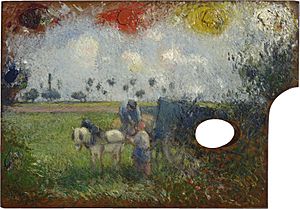
Camille's son Lucien was an Impressionist and Neo-Impressionist painter. So were his second and third sons Georges Henri Manzana Pissarro and Félix Pissarro. Lucien's daughter Orovida Pissarro was also a painter. Camille's great-grandson, Joachim Pissarro, became a top curator at the Museum of Modern Art in New York City. He is also a professor at Hunter College. Camille's great-granddaughter, Lélia Pissarro, has shown her work alongside her great-grandfather's. Another great-granddaughter, Julia Pissarro, is also active in the art world. From Camille's only daughter, Jeanne Pissarro, other painters include Henri Bonin-Pissarro (1918–2003) and Claude Bonin-Pissarro (born 1921). Claude is the father of the Abstract artist Frédéric Bonin-Pissarro (born 1964).
Camille Pissarro's grandson, Hugues Claude Pissarro (also known as Pomié), was born in 1935. He started drawing and painting as a young child, taught by his father. As a teenager and young adult, he studied the works of great masters at the Louvre. His work has been shown in Europe and the United States. In 1959, he was asked by the White House to paint a portrait of U.S. President Dwight Eisenhower. He now lives and paints in Donegal, Ireland, with his wife Corinne, who is also an artist, and their children.
Images for kids
-
A Plaza in Caracas, c. 1850–52.
-
Camille Pissarro, Portrait of Paul Cézanne, 1874.
-
A Crossroads at L'Hermitage, Pontoise, 1876.
-
Red Roofs, Corner of a Village, Winter, Côte de Saint-Denis, Pontoise, 1877.
-
View from Upper Norwood, c. 1870.
See also
 In Spanish: Camille Pissarro para niños
In Spanish: Camille Pissarro para niños


